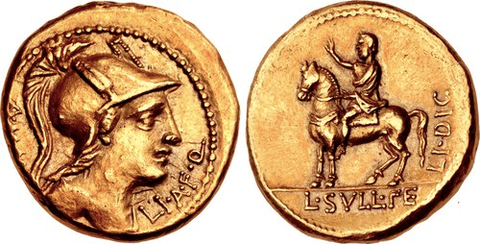Coins of the Roman Republic

A small hoard of Republic Denarii. A denarius was a day’s wage.
Courtesy of Classical Numismatics Group
As we unravel the fascinating phases of Roman currency and its impact on trade, power, and the rise of an empire, the coinage of the earliest days of Rome are completely separate from those minted during the high Imperial age. These enticing artifacts of history span a range of nearly three hundred years, and are generally divided into three major phases. The first and earliest phase applies to coinage minted before the first Punic War around 250 BC. The first silver coinage did not appear until around 215 BC, so the earliest phase in Roman Republic coinage pertains to bronze issues. These large bronze cast coins were called AES GRAVE (coins of high tin and lead bronze purity) and were issued in various denominations. The economy was dominated by the AES GRAVE. These coins, equivalent in weight to the Roman Libra, served as the foundational unit of the entire coinage system, likely valued at one As. The AES GRAVE series comprised six denominations, each distinguished by a signet representing its value in Libra and accompanied by a unique design. The weight of these coins varied depending on the issuing moneyer, with the value of the AES GRAVE experiencing a significant decline towards the end of the Punic Wars. Notably, most coins in this series featured a Galley, symbolizing their association with merchant transactions, as higher-value coins were primarily exchanged in the open market. Consequently, it is plausible that the general population rarely employed AES GRAVE coins in their everyday transactions.

A large AES GRAVE As weighing a staggering 260 grams
Courtesy of Classical Numismatics Group
Phase two of Roman Republic coinage involves the first Denarii (initially issued anonymously) and the first gold Staters issued for emergency purposes. The first Denarii were issued with the deity Roma on the obverse and a biga or quadriga chariot on the reverse. Often, the initial anonymous issues had the legend "ROMA" inscribed on the reverse to signify the Rome mint.

Aureus issued around 80 BC. Minted after the Jugurthine War.
Courtesy of Classical Numismatics Group
Phase three is the shortest and starts around 70 BC during the time of Julius Caesar. This shift in coinage involved the main Triumvirs of the Roman Civil War, and also includes Julius Caesar, Clodius Macer, Cassius, Brutus, and Pompey. The gold Aureus was issued during this phase and continued to be minted during the ascension of Octavian into the Roman Empire.
Indeed, the most abundant Roman Republic coinage is the silver Denarii, which were issued for nearly five centuries. Every coin had a mandatory specific weight of about 3.2-3.7 grams depending on the accuracy of the planchet. The large bronze cast coins were also issued with a specific weight, although their value caused fluctuations in weight. For example, at times, the AES GRAVE As weighed upwards of 255 grams, but towards the end of the Republic, it weighed a mere 30 grams. Further on, copper was the most abundant metal in the later Roman empire, accounting for approximately 80% of all precious metal trade. Due to this abundance, inflationary rates skyrocketed as the Republic grew.
Julius Caesar’s coins received significant backlash. Before him, most official coinage featured a god or deity symbol and rarely an actual person. This change was fairly unpopular with the Roman people.
The coins of the Republic were primarily used to support the government through trade and taxes. Greek coins, which often circulated through commerce, were the most abundant type and were widely used among the Roman people. Day-to-day transactions did not require high-denomination bronze coins or expensive silver ones. Gold coins were only issued during emergencies (such as for war efforts or large transactions) and were impractical compared to the abundance of Greek gold readily available and in circulation. The early Republic made efforts to establish monetary isolation through different denominations, but this idea was not fulfilled until Caesar Augustus issued smaller coins that could be used by the people. Consequently, inflation was practically non-existent, items cost less, and overall taxes were not a burdensome fee but rather a part of daily life.

Denarius minted 42 BC. The obverse reads the moneyer C. Cassius Longinus.
Courtesy of Classical Numismatics Group
The issuance of Roman Republic coins relied heavily on the appointed moneyers who held the responsibility of designing the coins, ensuring proper weights, and overseeing the striking process. Their competence or lack thereof could have profound consequences for the economy. Among the coins regularly issued by moneyers, the silver Denarius stood out as one of the few that frequently bore their names. These names could either refer to the issuer of the coin type or a government official and influential figure seeking recognition on the currency.
Typically, the right to mint coins as a moneyer was a direct appointment from the government. The individual holding the position of Triumvir Monetalis, or monetary official, was tasked with maintaining the coins' correct weight, purity, and circulation. Often, these monetary officials were young politicians with a sound understanding of economics. They recognized the risks of excessive coin circulation leading to devaluation, as well as the dangers of insufficient circulation resulting in hoarding. Striking a balance to sustain a stable economy proved to be a challenging task. In the Roman Republic, three official moneyers were stationed in the capital of Rome at any given time, with any other provincial or military moneyers prohibited from minting coins without proper authorization from their superiors.
The Actium War, the second Roman civil war occurring from 32-30 BC., served as a pivotal moment in the transition from the Roman Republic to the Roman Empire. Octavian, who later became known as Augustus, emerged victorious by defeating Brutus, restoring order to the empire, and compelling Marc Antony and Cleopatra to meet their demise in Egypt. In commemoration of his triumph in Egypt, a series of coins featuring a Nile crocodile and the inscription "AEGYPTO CAPTA" were issued, symbolizing the conquest and downfall of Ptolemaia.
Now known as Augustus, he continued to mint coins that celebrated his military campaigns in Germania, Armenia, and Asia. Augmenting the Roman coinage system, Augustus reevaluated the usage of high-value currency, transforming it into a dominant monetary force that compelled nations across the world to adopt the Roman standard of coinage. Demonstrating astuteness, Augustus introduced coins with a standardized value based on multiples and fractions of Librae (pound). Simultaneously, he issued small bronze coins intended for use as change denominations, ensuring the convenience of Roman coinage for both trade and local commerce. This achievement mirrored the practices of certain ancient Greek city-states, but under Augustus' rule, it became more widespread, establishing a lasting legacy.

Egypt Capta Denarius minted by Augustus.
Courtesy of Classical Numismatics Group
Under the reign of Augustus, a remarkable commemorative Denarius was issued in honor of the late Julius Caesar. This coin aimed to immortalize Caesar as a revered and divine figure whose legacy would endure for centuries. The posthumous title "Divus," meaning god, adorned the coin, emphasizing Caesar's elevated status. Struck around 17 BC, these Denarii likely commemorated the 27th anniversary of Caesar's death, a significant number in Roman culture symbolizing trinity and wholeness (3x3x3=27, 3×3=9, and 3×9=27).
Notably, Caesar's deified portrait on these coins featured a star positioned just above his head. This celestial emblem became known as the "Julian star" and held symbolic significance. It referred to a prominent comet that illuminated the night sky on the day of Caesar's assassination, adding a mythical aura to his memory. By incorporating this celestial element, the commemorative Denarius captured the grandeur and enduring impact of Julius Caesar's life and legacy.

The “Julian Star”
Courtesy of Classical Numismatics Group
Article By. Colby J. Abele

